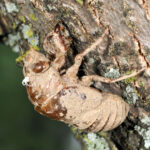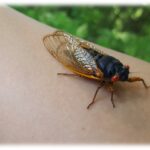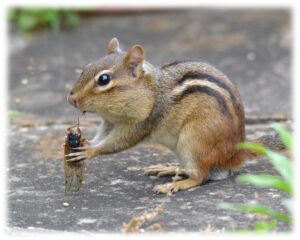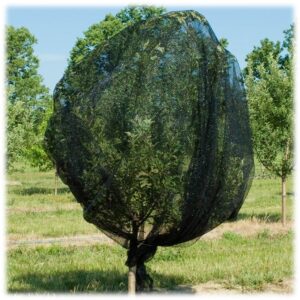A natural wonder will occur in 15 states this year: the emergence of the Brood X, 17-year periodical cicadas! Also known as “17-year or 13-year locusts” the last mass emergence of these insects occurred in 2004. Now, 17 years later, the immature cicadas will emerge from the ground, molt one last time to gain wings, and “sing” loudly to find mates and lay eggs in trees and woody shrubs.
Periodical cicadas
There are six known species of periodical cicadas and five of them occur in Indiana. Brood X will emerge late May through June in all Indiana counties, but activity will be heaviest in south-central Indiana. You will see two distinct life stages of these charismatic insects: the nymphs and the adults.
Although there is no single degree day model to predict the emergence accurately across regions, it’s generally agreed that when soil temperatures warm up to 65 °F or so, the nymphs will begin to emerge from the soil. The nymphs are wingless, just a bit creepy, and dark golden-brown in color (Figure 1). After emerging from the ground, nymphs crawl up tree trunks and items like patio furniture, to molt – leaving behind their cast skin (exoskeleton).
The adults are 1.5 to 2-inches long, with black bodies and reddish-colored legs, wing margins, and eyes (Figure 2). Newly emerged adults may appear pale or white in color until the exoskeleton has hardened and darkened (Figure 3). Adult periodical cicadas live for ~1 month, and during this time the males produce shrill “songs” to attract females using vibrating organs called tymbals – how romantic! Females cut slits into twigs of woody plants to lay eggs that hatch in 6-7 weeks. After hatching, the next generation of 17-year cicada nymphs drop to the ground and dig down into the soil, where they will remain for another 17 years feeding on sap from tree roots.
- Figure 1. Periodical cicada nymph (cast ‘skin’). Photo: John Obermeyer
- Figure 2. An adult periodical cicada on my arm.
- Figure 3. A newly emerged adult periodical cicada, before its exoskeleton has hardened and darkened. Photo: Jane Chandler
Why the mass emergence? This is a life history strategy to satiate predators (Figure 4, they can’t eat them all!) and maximize the chances that the majority of periodical cicadas will survive to mate and lay eggs.
Damage
- The good news is periodical cicadas do not bite or sting people, or pets.
- The bad news is females lay eggs in 200+ woody tree species and can cause severe to damage young trees (Figure 5). (See Periodical Cicada in Indiana to learn more about landscape and ornamental plants that are attacked by periodical cicada).
In orchards: apples, cherries, peaches, plums, and grapevines are at high risk, because these hosts are preferred for egg laying by female cicadas. However, any young trees with main branches and stems between 3/16” and 7/16” in diameter are susceptible to damage, and so these trees should be the main focus of protective efforts.
Egg laying physically weakens and damages branches, which may turn brown, die, and break off (“flagging”). Under heavy attack, the loss of branches can cause serious damage or death to young trees. It is also possible that nymphs feeding on tree roots reduces vigor.
Management
Step #1: Cultural control
- Delay new plantings in 2021, either until the emergence has ended, or next spring.
- Plan accordingly for future emergence of periodical cicadas broods in Indiana (Table 1, below).
Table 1. When and where 13-year and 17-year periodical cicadas will emerge in Indiana in the future.
| Brood number | Race | Year to appear | Where they will appear |
| VI (6) | 17-year | 2034 | Reported in all IN counties in 2017, but may be a “shadow brood” of brood X. |
| X (10) | 17-year | 2021 | All counties, but heaviest in south-central IN; largest of 17-yr broods. |
| XII (12) | 17-year | 2023 | Allen & Orange counties; scarce in IN. |
| XIII (13) | 17-year | 2024 | Lake, LaPorte, & Porter counties. |
| XIV (14) | 17-year | 2025 | 40 counties, but heaviest in SW IN; dense swarms expected in Brown & Warrick. |
| XIX (19) | 13-year | 2024 | 8 western counties, from Posey & Warrick on the south to Newton and Jasper on the north. |
| XXIII (23) | 13-year | 2028 | 21 counties, mostly in SW IN, with Fountain, Tippecanoe, & Fayette the northern limits. |
Step #2: Mechanical control (recommended for small orchards/backyard fruit trees/organic production)
- Net trees with mesh screening (no larger than 1/2-inch openings), when first males begin singing (before egg laying begins), to prevent females from accessing trees to deposit eggs.
Cover trees and tie the netting to the trunk below the lower branches (Figure 6). Remove after adult periodical cicada activity ends.
- Prune branches after egg laying ends, to remove damaged wood and infested branches from the orchard.
Remove pruned, infested branches 4-6 weeks after egg laying to prevent nymphs from entering soil and feeding on tree roots.
Step #3: Chemical control (recommended for settings where netting is not feasible, like large/commercial orchards)
IMPORTANT: Chemical control is not as effective as netting. While netting is applied once to exclude egg-laying females, insecticides must be applied repeatedly against “waves of cicadas” during the ~1-month activity period of adults to prevent or reduce injury to trees.
Insecticides are not recommended to protect large trees, because these trees can tolerate egg laying damage. However, insecticide applications can reduce periodical cicada injury to small trees:
- Once egg laying begins, insecticides may be applied:
- Every 3-4 days, to help prevent injury, or
- Every 7-10 days, to help reduce injury
- Soil-applied, systemic insecticides are not effective against periodical cicadas.
Scout orchards every 2-3 days during egg laying to evaluate how well insecticide applications are protecting young trees.
Pyrethroid insecticides are recommended against periodical cicadas because they have fast knock down and good residual activity; however, commercial producers should beware flare-ups of spider mites when using pyrethroid insecticides like Baythroid XL (active ingredient: cyfluthrin), and Mustang Maxx (active ingredient: zeta-cypermethrin) against periodical cicadas, because they also kill beneficial, predatory mites that typically keep spider mites at bay.
Commercial producers can refer to the 2021-2022 Midwest Fruit Pest Management Guide for insecticide recommendations.
Homeowners can use products with active ingredients permethrin (Bonide Eight), zeta-cypermethrin (GardenTech Sevin), or gamma-cyhalothrin (Spectracide Triazicide Concentrate for Lawns and Landscapes) against periodical cicada on backyard fruit and ornamental trees and shrubs.
For your safety, always read and follow the instructions on pesticide labels.
In summary, here are some quick “take home messages:”
- 17-year cicada emergence will occur in all Indiana counties late May through June, but will be heaviest in south-central Indiana.
- Female cicadas damage twigs and branches 3/16” to 7/16” in diameter by cutting into them to lay eggs.
- If you have an orchard or backyard fruit trees: prepare to take action when you hear the first males begin to “sing.”
- Focus protective efforts (netting, insecticide applications) on young trees, because they are most vulnerable.
- Select and use insecticides judiciously to reduce flare-ups of secondary pests, like spider mites.





